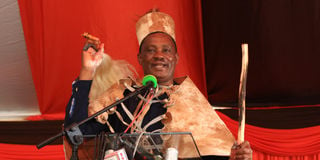Shrines the new sites of bruising political battles ahead of Uhuru exit

National Assembly Speaker Justin Muturi addresses the Kikuyu Council of Elders after he was crowned Mt Kenya spokesman at the Agikuyu Mukurwe wa Nyagathanga shrine in Murang'a County on May 22, 2021.
What you need to know:
- Obviously, shrines in themselves can’t make presidents – or can they?
- This role rests with the terms set out in Kenya’s 2010 Constitution.
Shrines are the new sites of re-engineering power. These holy spaces are the lynchpins of African political thought. In envisioning the future of power in Kenya, Jomo Kenyatta, Kenya’s founding President, celebrated the unity of “the dispossessed youth of Africa… the dead, the living and the unborn” in rebuilding “the destroyed shrines” (Facing Mount Kenya, 1938).
Allan Dawson argues in his widely read book, Shrines in Africa (2009) that shrines “in all their variable and diverse forms, are more than just spiritual vessels or points of worship”. Instead, these sanctuaries “are powerful symbols of solidarity, group cohesion, and knowledge about the landscape”. As cultural signposts that symbolically connect a political community with the physical landscape and the supernatural, shrines are the ultimate source of power and legitimacy.
Obviously, shrines in themselves can’t make presidents – or can they? This role rests with the terms set out in Kenya’s 2010 Constitution.
However, as the Mount Kenya region gets sucked into the vortex of fierce power struggles ahead of the 2022 elections, sacred spaces are the new scenes of the battle for the Kenyatta succession.
Shrines are neither barbaric nor regressive. They are to be found in many of the world’s religions. The Christian bible has 27 verses about anointment and 13 verses on coronation of kingpins.
The cultural route is one of the three emerging grand strategies in the intra-elite power struggles. The first strategy, identified with the March 2018 “handshake” and the Building Bridges Initiative (BBI), is the change-the-constitution route to build political momentum ahead of 2022.
The second, epitomised by the ‘hustler movement’, is a populist path that taps deep into the veins of ethnicity, class and Christian evangelicalism. Third is a return to the “roots”, a re-traditionalisation of power in the intra-ethnic supremacy battles in the Rift Valley and Mount Kenya regions.
Succession battles
On June 12, 2020, elders of the Talai clan, believed to possess mystic powers to bless or curse, installed Deputy President William Ruto as the Kalenjin community’s new kingpin in Kipsirwo in Kapsisiywa village in Nandi County. The dawn ceremony, however, split the Talai elders. Youths allied to Mr Ruto blocked Baringo Senator Gideon Moi from accessing the Kapsisiywo site to be installed as the overall Kalenjin leader on January 2, 2021.
The senator was eventually crowned Kalenjin kingpin by Talai elders, led by their chairman Christopher Koyogi on January 22, 2021.
President Kenyatta’s impeding exit from power has stoked fierce succession battles. With the dwindling fortunes of the BBI route to power and visible battleground victories in by-elections by the ‘hustler nation’, the battle for the soul of Mount Kenya’s nearly 14 million people has also taken a cultural turn.
The epicentre of this battle is a 4.5-acre piece of land that forms the Mukurwe-wa-Nyagathanga shrine in Murang'a County, the cradle of the Kikuyu people, the largest ethnic group in Kenya with a population of 8,148,668 (17.13 per cent of the total population) as of 2019.
The coronation of National Assembly Speaker Justin B. Muturi at the enchanted Mukurwe-wa-Nyagathanga shrine yesterday is a game-charger in the Uhuru succession politics.
Certainly, Muturi is not the first politician to be coronated at the shrine. In September 2011, prayers were held there for the then Deputy Prime Minister Uhuru Kenyatta ahead of his travel to The Hague for the International Criminal Court (ICC) hearing. And in October 2012, Njenga Karume was coronated here as the chairman of the Kikuyu Council of Elders and as the patron of the Gikuyu, Embu and Meru communities (Gema).
Muturi’s journey started in February 2022, when he was inaugurated as Mount Kenya spokesman by Kiama-kia-Ngome from his Mbeere community and Nyaangi Ndiriri, both in Embu County.
Fierce resistance
On March 6, the Njuri Ncheke elders coronated him as regional spokesman at the Njuri Ncheke Shrine in Nchiru, Tigania West, Meru County.
The recent endorsement by Kiama Kia Ma – which draws its membership from Kikuyu-speaking counties of Kiambu, Murang'a, Nyandarua, Kirinyaga, Nakuru, Nyeri and Laikipia – has now confirmed him the spokesperson for the entire region.
On May 21, the three governors from Mount Kenya East, including Kiraitu Murungi (Meru), Muthomi Njuki (Tharaka Nithi) and Martin Wambora (Embu), who is also the Chairman of the Council of Governors, endorsed the Speaker.
His coronation, however, attracted fierce resistance from Murang’a Governor Mwangi wa Iria, in what could lead to an East-West divide.
Muturi comes from the smallest of the Mount Kenya communities, the Ambeere, estimated at 195,250 people as of 2019 who inhabit an area of 2,093 square kilometres in Embu County. Mount Kenya East is calling in its debt from the Kikuyu community.
Besides being compatriots in the Mau Mau struggle for independence in the 1950s, for nearly six decades the Embu, Meru, Mbeere and Tharaka have supported Kikuyu leaders, including Jomo Kenyatta (1963-1978), Mwai Kibaki (2003-2013) and Uhuru Kenyatta (2013-2022).
With his elevation, Muturi is the natural heir to Uhuru Kenyatta. He is the third-highest ranking politician in the land. For nine years as Speaker, Muturi has not been tainted with the kind of scandals that have bedevilled Kenya’s political elite.
His political choices are stark: to align himself to either the Tangatanga or Kieleweke wings of the ruling Jubilee Party or chart a new path that asserts the unity, autonomy and leadership of the region in the 2022 transition.
Professor Peter Kagwanja is a former Government Adviser and currently Chief Executive of the Africa Policy Institute





